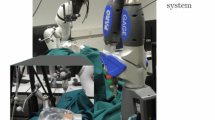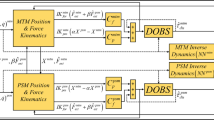Abstract
Purpose
Robotic assistance in otologic surgery can reduce the task load of operating surgeons during the removal of bone around the critical structures in the lateral skull base. However, safe deployment into the anatomical passageways necessitates the development of advanced sensing capabilities to actively limit the interaction forces between the surgical tools and critical anatomy.
Methods
We introduce a surgical drill equipped with a force sensor that is capable of measuring accurate tool–tissue interaction forces to enable force control and feedback to surgeons. The design, calibration and validation of the force-sensing surgical drill mounted on a cooperatively controlled surgical robot are described in this work.
Results
The force measurements on the tip of the surgical drill are validated with raw-egg drilling experiments, where a force sensor mounted below the egg serves as ground truth. The average root mean square error for points and path drilling experiments is 41.7 (± 12.2) mN and 48.3 (± 13.7) mN, respectively.
Conclusion
The force-sensing prototype measures forces with sub-millinewton resolution and the results demonstrate that the calibrated force-sensing drill generates accurate force measurements with minimal error compared to the measured drill forces. The development of such sensing capabilities is crucial for the safe use of robotic systems in a clinical context.








Similar content being viewed by others
References
Simaan N, Taylor RH, Choset H (2015) Intelligent surgical robots with situational awareness. Mech Eng 137(09):3–6
Trejos A, Patel R, Naish M (2010) Force sensing and its application in minimally invasive surgery and therapy: a survey. Proc Inst Mech Eng C J Mech Eng Sci 224(7):1435–1454
Taylor RH, Menciassi A, Fichtinger G, Fiorini P, Dario P (2016) Medical robotics and computer-integrated surgery. Springer handbook of robotics, USA
Taylor R, Jensen P, Whitcomb L, Barnes A, Kumar R, Stoianovici D, Gupta P, Wang Z, Dejuan E, Kavoussi L (1999) A steady-hand robotic system for microsurgical augmentation. Int J Robot Res 18(12):1201–1210
Kubus D, Kroger T, Wahl FM (2008) Improving force control performance by computational elimination of non-contact forces/torques. In: 2008 IEEE international conference on robotics and automation pp 2617–2622. IEEE
Sang H, Monfaredi R, Wilson E, Fooladi H, Preciado D, Cleary K (2017) A new surgical drill instrument with force sensing and force feedback for robotically assisted otologic surgery. J Med Devices 11(3):205
Su H, Qi W, Yang C, Sandoval J, Ferrigno G, De Momi E (2020) Deep neural network approach in robot tool dynamics identification for bilateral teleoperation. IEEE Robot Auto Lett 5(2):2943–2949
Rothbaum DL, Roy J, Stoianovici D, Berkelman P, Hager GD, Taylor RH, Whitcomb LL, Francis HW, Niparko JK (2002) Robot-assisted stapedotomy: micropick fenestration of the stapes footplate. Otolaryngol Head Neck surg 127(5):417–426
Rothbaum DL, Roy J, Hager GD, Taylor RH, Whitcomb LL, Francis HW, Niparko JK (2003) Task performance in stapedotomy: comparison between surgeons of different experience levels. Otolaryngol Head Neck Surg 128(1):71–77
Miroir M, Nguyen Y, Szewczyk J, Mazalaigue S, Ferrary E, Sterkers O, Grayeli AB (2010) Robotol: from design to evaluation of a robot for middle ear surgery. In: 2010 IEEE/RSJ international conference on intelligent robots and systems pp 850–856. IEEE
Maier T, Strauss G, Hofer M, Kraus T, Runge A, Stenzel R, Gumprecht J, Berger T, Dietz A, Lueth TC (2010) A new micromanipulator system for middle ear surgery. In: 2010 IEEE international conference on robotics and automation pp 1568–1573. IEEE
Taylor R, Du X, Proops D, Reid A, Coulson C, Brett P (2010) A sensory-guided surgical micro-drill. Proc Inst Mech Eng C J Mech Eng Sci 224(7):1531–1537
Olds KC, Chalasani P, Pacheco-Lopez P, Iordachita I, Akst LM, Taylor RH (2014) Preliminary evaluation of a new microsurgical robotic system for head and neck surgery. In: 2014 IEEE/RSJ international conference on intelligent robots and systems, pp 1276–1281. IEEE
Olds K (2015) Robotic assistant systems for otolaryngology-head and neck surgery. PhD thesis, Johns Hopkins University
Dillon NP, Kratchman LB, Dietrich MS, Labadie RF, Webster RJ III, Withrow TJ (2013) An experimental evaluation of the force requirements for robotic mastoidectomy. Otol Neurotol 34(7):93
Funding
This work was supported in part by a grant from Galen Robotics, in part by Johns Hopkins University internal funds, and in part by NIDCD K08 Grant DC019708. Project Number: 90072284
Author information
Authors and Affiliations
Corresponding author
Ethics declarations
Conflict of interest
Under a license agreement between Galen Robotics, Inc and the Johns Hopkins University, Russell H. Taylor and Johns Hopkins University are entitled to royalty distributions on technology that may possibly be related to that discussed in this publication. Dr. Taylor also is a paid consultant to and owns equity in Galen Robotics, Inc. This arrangement has been reviewed and approved by the Johns Hopkins University in accordance with its conflict-of-interest policies.
Additional information
Publisher's Note
Springer Nature remains neutral with regard to jurisdictional claims in published maps and institutional affiliations.
Rights and permissions
Springer Nature or its licensor (e.g. a society or other partner) holds exclusive rights to this article under a publishing agreement with the author(s) or other rightsholder(s); author self-archiving of the accepted manuscript version of this article is solely governed by the terms of such publishing agreement and applicable law.
About this article
Cite this article
Chen, Y., Goodridge, A., Sahu, M. et al. A force-sensing surgical drill for real-time force feedback in robotic mastoidectomy. Int J CARS 18, 1167–1174 (2023). https://doi.org/10.1007/s11548-023-02873-7
Received:
Accepted:
Published:
Issue Date:
DOI: https://doi.org/10.1007/s11548-023-02873-7




